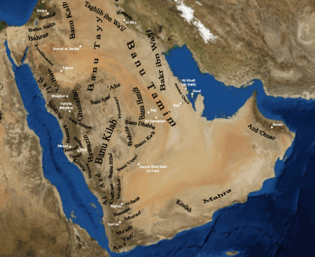Banu Najjar
Banu Najjar (Arabic: بنو نجّار, "sons of the carpenter") or Banu al-Naggar is the name of several unrelated historical and modern-day tribes throughout the Arab world. The individual tribes vary in religious composition.[1]

In Islamic history
One Banu Najjar group is mentioned in the Charter of Medina, and the Banu Najjar of Medina were the maternal clan of Muhammad's grandfather Abdul-Muttalib.[2] Islamic historians like Ibn Hajar al-Asqalani and al-Tabari list them as a clan of the large Banu Khazraj tribe of Medina. Al-Asqalani states that their ancestor was Taymallah ibn Thalabah ibn Amr ibn al-Khazraj.[3][4] The Banu Najjar had at least three sub-clans.[5]
Before Islam, the Banu Najjar of Medina mainly practiced traditional Arab polytheism, and owned idols named Samul, Husa, and at-Tamm that were destroyed after the clan converted to Islam.[5] They may have had a tribal alliance with some of the Jews of Medina.[6][5]
Muhammad initially settled with them when he emigrated from Mecca to Medina. The Prophet's Mosque was later built in the tribe's garden.[7] The Banu Najjar are praised in a hadith attributed to Muhammad.[8]
People
- Abu Ayyub al-Ansari
- Umm Sulaym bint Milham
- Zayd ibn Thabit
References
- "Banu Najjar". Retrieved 20 October 2018.
- Power, Edmond (1914). "The Life, Work, and Character of Mohammed". Studies: An Irish Quarterly Review. 3 (10): 142–159.
- Ibn Hajar al-Asqalani (1986). Fath al-Bari. page 144.
- al-Tabari, Abu Jafar. The History of al-Tabari Vol. 6: Muhammad at Mecca. p. 125. ISBN 9780887067075.
- FE Peters, ed. (2014). "Idol Worship in Pre-Islamic Medina". The Arabs and Arabia on the Eve of Islam (Volume 3). Routledge. pp. 130–134, 153. ISBN 9781351894807.
- Guillaume, Alfred (1963). "New light on the life of Muhammad". Bulletin of the School of Oriental and African Studies. 26 (2): 427–428.
- "Sahih Bukhari". Retrieved 20 October 2018.
- "Sahih Bukhari". Retrieved 20 October 2018.